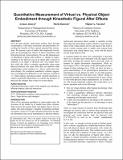Files in this item
Quantitative measurement of virtual vs. physical object embodiment through kinesthetic figural after effects
Item metadata
| dc.contributor.author | Alzayat, A. | |
| dc.contributor.author | Hancock, M. | |
| dc.contributor.author | Nacenta, M.A. | |
| dc.date.accessioned | 2014-09-10T11:01:01Z | |
| dc.date.available | 2014-09-10T11:01:01Z | |
| dc.date.issued | 2014-04-26 | |
| dc.identifier.citation | Alzayat , A , Hancock , M & Nacenta , M A 2014 , Quantitative measurement of virtual vs. physical object embodiment through kinesthetic figural after effects . in Conference on Human Factors in Computing Systems - Proceedings : CHI 2014 . ACM , pp. 2903-2912 . https://doi.org/10.1145/2556288.2557282 | en |
| dc.identifier.isbn | 9781450324731 | |
| dc.identifier.other | PURE: 143695514 | |
| dc.identifier.other | PURE UUID: 948dd74d-5962-46ad-a23b-43853f553edb | |
| dc.identifier.other | Scopus: 84900417398 | |
| dc.identifier.other | ORCID: /0000-0002-9864-9654/work/34034537 | |
| dc.identifier.uri | https://hdl.handle.net/10023/5400 | |
| dc.description | Funding: Natural Sciences and Engineering Council of Canada (NSERC), NSERC’s Digital Surface Software Application Network (Surfnet), and the Graphics Animation & New Media (GRAND) NCE. | en |
| dc.description.abstract | Over the past decade, multi-touch surfaces have become commonplace, with many researchers and practitioners describing the benefits of their natural, physical-like interactions. We present a pair of studies that empirically investigates the psychophysical effects of direct interaction with both physical and virtual artefacts. We use the phenomenon of Kinesthetic Figural After Effects-a change in understanding of the physical size of an object after a period of exposure to an object of different size. Our studies show that, while this effect is robustly reproducible when using physical artefacts, this same effect does not manifest when manipulating virtual artefacts on a direct, multi-touch tabletop display. We contribute quantitative evidence suggesting a psychophysical difference in our response to physical vs. virtual objects, and discuss future research directions to explore measurable phenomena to evaluate the presence of physical-like changes from virtual on-screen objects. | |
| dc.format.extent | 10 | |
| dc.language.iso | eng | |
| dc.publisher | ACM | |
| dc.relation.ispartof | Conference on Human Factors in Computing Systems - Proceedings | en |
| dc.rights | © Owner/Authors 2014. This is the author's version of the work. It is posted here for your personal use. Not for redistribution. The definitive Version of Record was published in the Proceedings of the SIGCHI Conference on Human Factors in Computing Systems (CHI '14), http://dx.doi.org/10.1145/2556288.2557282. The copy of record of the paper can be found in: http://dl.acm.org/citation.cfm?doid=2556288.2557282 | en |
| dc.subject | Embodied interaction | en |
| dc.subject | Multi-touch | en |
| dc.subject | Physical interaction | en |
| dc.subject | Tabletop displays | en |
| dc.subject | Tangible user interfaces | en |
| dc.subject | QA75 Electronic computers. Computer science | en |
| dc.subject.lcc | QA75 | en |
| dc.title | Quantitative measurement of virtual vs. physical object embodiment through kinesthetic figural after effects | en |
| dc.type | Conference item | en |
| dc.description.version | Postprint | en |
| dc.contributor.institution | University of St Andrews. School of Computer Science | en |
| dc.identifier.doi | https://doi.org/10.1145/2556288.2557282 |
This item appears in the following Collection(s)
Items in the St Andrews Research Repository are protected by copyright, with all rights reserved, unless otherwise indicated.

